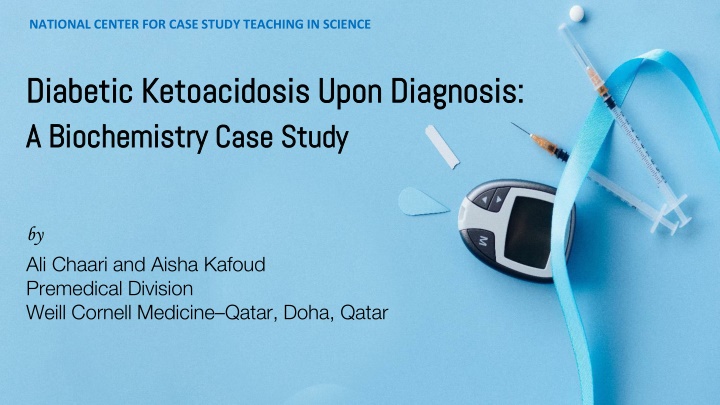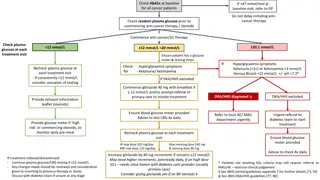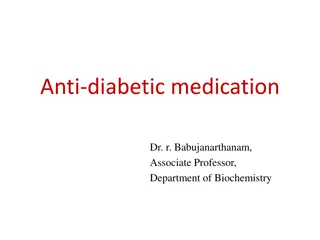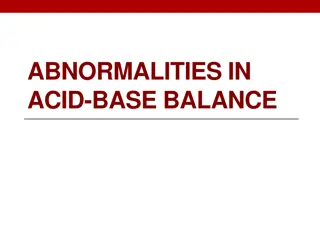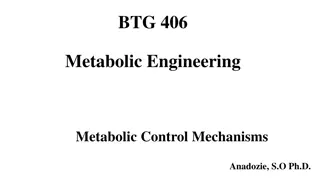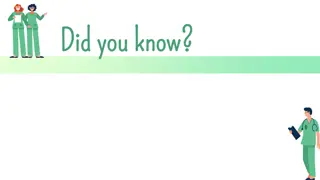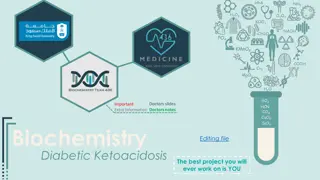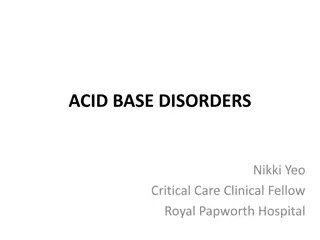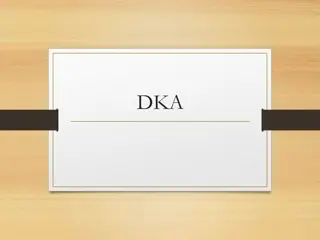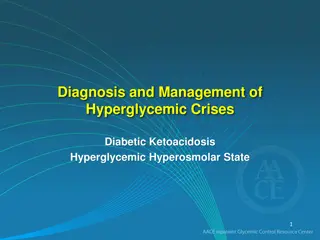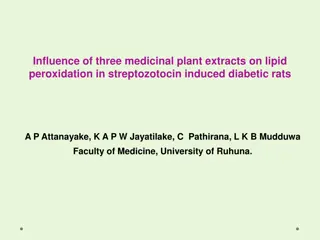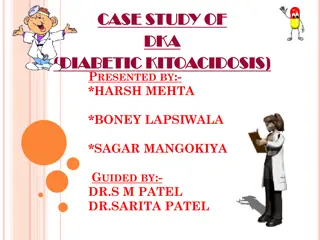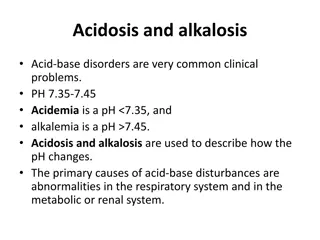Diabetic Ketoacidosis: Understanding Metabolic Acidosis in Diabetes
Explore a case study on diabetic ketoacidosis to understand the basis of metabolic acidosis in type 1 diabetes mellitus, differentiate between type 1 and type 2 diabetes, predict blood buffer equilibrium changes, apply Winter's formula, correlate clinical data with biochemical tests, explain insulin's role, and identify symptoms of diabetic ketoacidosis.
Download Presentation

Please find below an Image/Link to download the presentation.
The content on the website is provided AS IS for your information and personal use only. It may not be sold, licensed, or shared on other websites without obtaining consent from the author.If you encounter any issues during the download, it is possible that the publisher has removed the file from their server.
You are allowed to download the files provided on this website for personal or commercial use, subject to the condition that they are used lawfully. All files are the property of their respective owners.
The content on the website is provided AS IS for your information and personal use only. It may not be sold, licensed, or shared on other websites without obtaining consent from the author.
E N D
Presentation Transcript
NATIONAL CENTER FOR CASE STUDY TEACHING IN SCIENCE Diabetic Ketoacidosis Upon Diagnosis: Diabetic Ketoacidosis Upon Diagnosis: A Biochemistry A Biochemistry Case Study Case Study by Ali Chaari and Aisha Kafoud Premedical Division Weill Cornell Medicine Qatar, Doha, Qatar
Learning Objectives 1) Understand some of the basis of metabolic acidosis in type 1 diabetes mellitus (T1DM). 2) Understand the differences between T1DM and T2DM. 3) Predict the behaviour of the blood buffer equilibrium in response to a physiological change. 4) Understand Winter s formula and perform calculations using real patient data. 5) Correlate real clinical data with biochemical tests. 6) Explain the role of insulin and how ketoacidosis can occur due to insulin insufficiency. 2
You might have the flu, just like your brother Hey dad I don t feel so good 3
Well, you dont have a fever Dad I really don t feel good. 4
I think we should go to the hospital. 5
Other than the vomiting, have you been feeling any different these past few weeks? I don t think so 6
Ive actually noticed plenty of strange symptoms. Was fatigue one of them? 7
Yeah. Shes been exhausted all the time. I thought it was because of school or something. Hmm.. Fatigue by itself isn t always a concern, anything else? Yup, she s been drinking a ridiculous amount of water. Not sure if that s normal. 8
Hey, is this endocrinology? We have a patient here in the ER. 9
She seems drowsy, but she s still conscious. Her breathing is shallow and pretty fast. I examined her and I noticed she sorta smelled like nail polish. We re about to send blood samples to the lab. 10
9 PM Sounds like diabetes. I ll come over soon. I thought so too. She has been vomiting non- stop and matches the presentation. 11
9 PM Did you get any tests done yet? Blood glucose? Ketones? I m looking at her lab results now. 12
13 The above values reflect lab values measured throughout AJ s admission
Question 1 Diabetes is characterised by elevated blood glucose. Does the patient have type 1 or type 2 diabetes? Support your answer with data from the physical examination, history, and laboratory values. 14
Question 2 What is the primary treatment for high blood glucose? What can be injected into AJ to treat her ketone bodies? Explain how each treatment works to improve these conditions. 15
Question 3 Suggest an explanation for the increased concentration of ketone bodies in the urine and a decrease of ketone bodies in blood from 9 11 PM. 16
Question 4 Explain why the concentration of ketone bodies is elevated concurrently with instances of high blood sugar. Use Figure 1 on the next slide to aid in answering. 17
Question 5 What caused the scent of nail polish in the patient? 19
Question 6 What is the net charge of -hydroxybutyric acid at physiological pH? Describe how and why the molecule affects blood pH. 20
11:30 PM Hi there! I m the endocrinologist! It s kind of getting hard to breathe 21
11:30 PM We re giving you a bicarb drip. Hopefully that helps you out. What on Earth is a bicarb drip? I didn t ask for that! 22
Question 7 Suggest a possible reason for the increase in bicarbonate concentration from 9 11 PM even though the bicarbonate drip had only been administered at 11:30 PM. 23
12 AM Hey, you don t look so good you re breathing pretty fast and deep. I m guessing you wouldn t feel so good if you were just told you had diabetes. 24
12 AM I ll let the endocrinologist know what s going on. 25
Around 12 AM, nurses report a new symptom to AJs assigned physician: her breathing has become increasingly fast and deep. Note that at the beginning of AJ s admission, her breathing was rapid, but shallow. This new pattern of breathing, known as Kussmaul respiration, is often seen in diabetic patients in diabetic ketoacidosis. This is an attempt by the respiratory system to increase blood pH by expelling carbon dioxide. AJ has not stopped vomiting. An IV antiemetic as well as a bicarbonate drip were administered at 11:30 PM. 26
Question 8 The body reacts to blood pH imbalances via compensatory responses. Is it possible for acidosis to directly cause an alkaline arterial pH? Justify your answer. 27
Winters formula is a mathematical formula used to calculate whether there is adequate respiratory compensation by the body in a state of metabolic acidosis by predicting the levels of dissolved carbon dioxide in the blood. The output of the formula is an expected pCO2, which is used as a point of comparison for actual, measured pCO2. 28
Question 9 Why would AJ s expulsion of CO2lead to an increase in blood pH? 29
Question 10 If the pCO2measured in the patient is higher than the predicted value, what acid-base imbalance does that suggest is occurring concurrently? 30
Question 11 Estimate AJ s pCO2at admission using Winter s formula. 31
Question 12 AJ s measured pCO2is found to be 16 mmHg. What does this say about AJ s respiratory compensation? 32
Discharge and Follow-Up After ketoacidosis and hyperglycemia were treated, AJ displayed enhanced mental clarity and less lethargy. Kussmaul respirations ceased around 3 AM. AJ was referred to the endocrinology department and was given a diagnosis of type 1 diabetes mellitus. It is not uncommon for diabetics to be diagnosed when having a life-threatening emergency such as DKA. T1DM is insulin dependent, and thus AJ was started on both long-acting (insulin glargine) and short-acting insulin therapy via injections and switched over to an insulin pump and continuous glucose monitor (CGM) after 3 4 months. 33
References 1. Savage MW. Management of diabetic ketoacidosis. Clin Med (Lond). 2011;11(2):154-156. doi:10.7861/clinmedicine.11-2-154 2. Misra S, Oliver NS. Utility of ketone measurement in the prevention, diagnosis and management of diabetic ketoacidosis. Diabet Med. 2015;32(1):14-23. doi:10.1111/dme.12604 3. Bruss ML. Chapter 4 - Lipids and Ketones. In: Kaneko JJ, Harvey JW, Bruss ML, eds. Clinical Biochemistry of Domestic Animals (Sixth Edition)Academic Press; 2008:81-115 4. Lyu X, Miskovsky J. Detecting Concealing Heart Failure in a Young Alcohol-Related Liver Failure Patient Using the Most Basic Pathophysiological Principle. Cureus. 2022;14(3):e23570. doi:10.7759/cureus.23570 34
